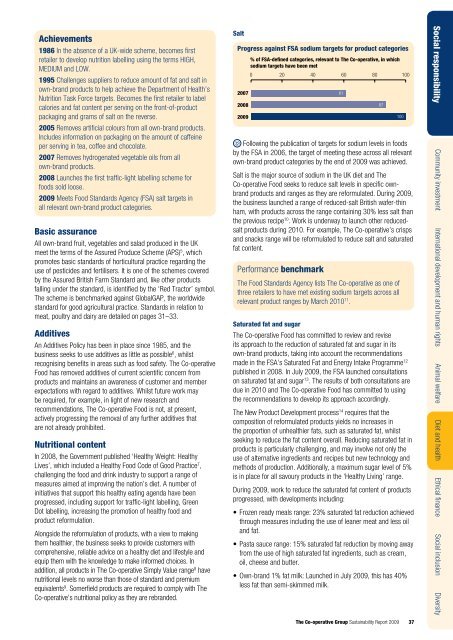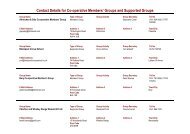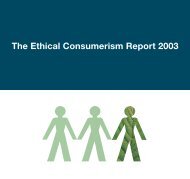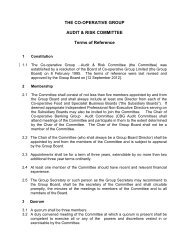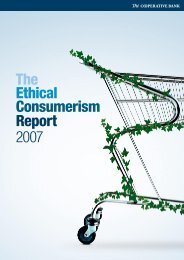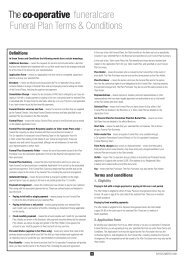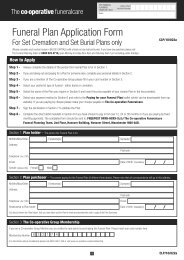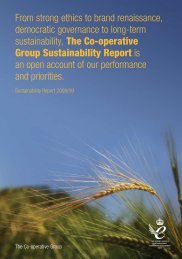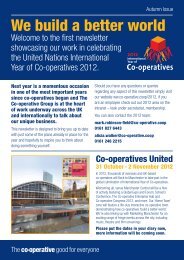Sustainability Report 2009 - The Co-operative
Sustainability Report 2009 - The Co-operative
Sustainability Report 2009 - The Co-operative
You also want an ePaper? Increase the reach of your titles
YUMPU automatically turns print PDFs into web optimized ePapers that Google loves.
Achievements<br />
1986 In the absence of a UK-wide scheme, becomes first<br />
retailer to develop nutrition labelling using the terms HIGH,<br />
MEDIUM and LOW.<br />
1995 Challenges suppliers to reduce amount of fat and salt in<br />
own-brand products to help achieve the Department of Health’s<br />
Nutrition Task Force targets. Becomes the first retailer to label<br />
calories and fat content per serving on the front-of-product<br />
packaging and grams of salt on the reverse.<br />
2005 Removes artificial colours from all own-brand products.<br />
Includes information on packaging on the amount of caffeine<br />
per serving in tea, coffee and chocolate.<br />
2007 Removes hydrogenated vegetable oils from all<br />
own-brand products.<br />
2008 Launches the first traffic-light labelling scheme for<br />
foods sold loose.<br />
<strong>2009</strong> Meets Food Standards Agency (FSA) salt targets in<br />
all relevant own-brand product categories.<br />
Basic assurance<br />
All own-brand fruit, vegetables and salad produced in the UK<br />
meet the terms of the Assured Produce Scheme (APS) 5 , which<br />
promotes basic standards of horticultural practice regarding the<br />
use of pesticides and fertilisers. It is one of the schemes covered<br />
by the Assured British Farm Standard and, like other products<br />
falling under the standard, is identified by the ‘Red Tractor’ symbol.<br />
<strong>The</strong> scheme is benchmarked against GlobalGAP, the worldwide<br />
standard for good agricultural practice. Standards in relation to<br />
meat, poultry and dairy are detailed on pages 31–33.<br />
Additives<br />
An Additives Policy has been in place since 1985, and the<br />
business seeks to use additives as little as possible 6 , whilst<br />
recognising benefits in areas such as food safety. <strong>The</strong> <strong>Co</strong>-<strong>operative</strong><br />
Food has removed additives of current scientific concern from<br />
products and maintains an awareness of customer and member<br />
expectations with regard to additives. Whilst future work may<br />
be required, for example, in light of new research and<br />
recommendations, <strong>The</strong> <strong>Co</strong>-<strong>operative</strong> Food is not, at present,<br />
actively progressing the removal of any further additives that<br />
are not already prohibited.<br />
Nutritional content<br />
In 2008, the Government published ‘Healthy Weight: Healthy<br />
Lives’, which included a Healthy Food <strong>Co</strong>de of Good Practice 7 ,<br />
challenging the food and drink industry to support a range of<br />
measures aimed at improving the nation’s diet. A number of<br />
initiatives that support this healthy eating agenda have been<br />
progressed, including support for traffic-light labelling, Green<br />
Dot labelling, increasing the promotion of healthy food and<br />
product reformulation.<br />
Alongside the reformulation of products, with a view to making<br />
them healthier, the business seeks to provide customers with<br />
comprehensive, reliable advice on a healthy diet and lifestyle and<br />
equip them with the knowledge to make informed choices. In<br />
addition, all products in <strong>The</strong> <strong>Co</strong>-<strong>operative</strong> Simply Value range 8 have<br />
nutritional levels no worse than those of standard and premium<br />
equivalents 9 . Somerfield products are required to comply with <strong>The</strong><br />
<strong>Co</strong>-<strong>operative</strong>’s nutritional policy as they are rebranded.<br />
Salt<br />
Progress against FSA sodium targets for product categories<br />
2007<br />
2008<br />
<strong>2009</strong><br />
% of FSA-defined categories, relevant to <strong>The</strong> <strong>Co</strong>-<strong>operative</strong>, in which<br />
sodium targets have been met<br />
0 20 40 60 80 100<br />
Following the publication of targets for sodium levels in foods<br />
by the FSA in 2006, the target of meeting these across all relevant<br />
own-brand product categories by the end of <strong>2009</strong> was achieved.<br />
Salt is the major source of sodium in the UK diet and <strong>The</strong><br />
<strong>Co</strong>-<strong>operative</strong> Food seeks to reduce salt levels in specific ownbrand<br />
products and ranges as they are reformulated. During <strong>2009</strong>,<br />
the business launched a range of reduced-salt British wafer-thin<br />
ham, with products across the range containing 30% less salt than<br />
the previous recipe 10 . Work is underway to launch other reducedsalt<br />
products during 2010. For example, <strong>The</strong> <strong>Co</strong>-<strong>operative</strong>’s crisps<br />
and snacks range will be reformulated to reduce salt and saturated<br />
fat content.<br />
Performance benchmark<br />
<strong>The</strong> Food Standards Agency lists <strong>The</strong> <strong>Co</strong>-<strong>operative</strong> as one of<br />
three retailers to have met existing sodium targets across all<br />
relevant product ranges by March 2010 11 .<br />
Saturated fat and sugar<br />
<strong>The</strong> <strong>Co</strong>-<strong>operative</strong> Food has committed to review and revise<br />
its approach to the reduction of saturated fat and sugar in its<br />
own-brand products, taking into account the recommendations<br />
made in the FSA’s Saturated Fat and Energy Intake Programme 12<br />
published in 2008. In July <strong>2009</strong>, the FSA launched consultations<br />
on saturated fat and sugar 13 . <strong>The</strong> results of both consultations are<br />
due in 2010 and <strong>The</strong> <strong>Co</strong>-<strong>operative</strong> Food has committed to using<br />
the recommendations to develop its approach accordingly.<br />
<strong>The</strong> New Product Development process 14 requires that the<br />
composition of reformulated products yields no increases in<br />
the proportion of unhealthier fats, such as saturated fat, whilst<br />
seeking to reduce the fat content overall. Reducing saturated fat in<br />
products is particularly challenging, and may involve not only the<br />
use of alternative ingredients and recipes but new technology and<br />
methods of production. Additionally, a maximum sugar level of 5%<br />
is in place for all savoury products in the ‘Healthy Living’ range.<br />
During <strong>2009</strong>, work to reduce the saturated fat content of products<br />
progressed, with developments including:<br />
• Frozen ready meals range: 23% saturated fat reduction achieved<br />
through measures including the use of leaner meat and less oil<br />
and fat.<br />
• Pasta sauce range: 15% saturated fat reduction by moving away<br />
from the use of high saturated fat ingredients, such as cream,<br />
oil, cheese and butter.<br />
• Own-brand 1% fat milk: Launched in July <strong>2009</strong>, this has 40%<br />
less fat than semi-skimmed milk.<br />
61<br />
87<br />
100<br />
Social responsibility <strong>Co</strong>mmunity investment International development and human rights Animal welfare Diet and health Ethical finance Social inclusion Diversity<br />
<strong>The</strong> <strong>Co</strong>-<strong>operative</strong> Group <strong>Sustainability</strong> <strong>Report</strong> <strong>2009</strong> 37


